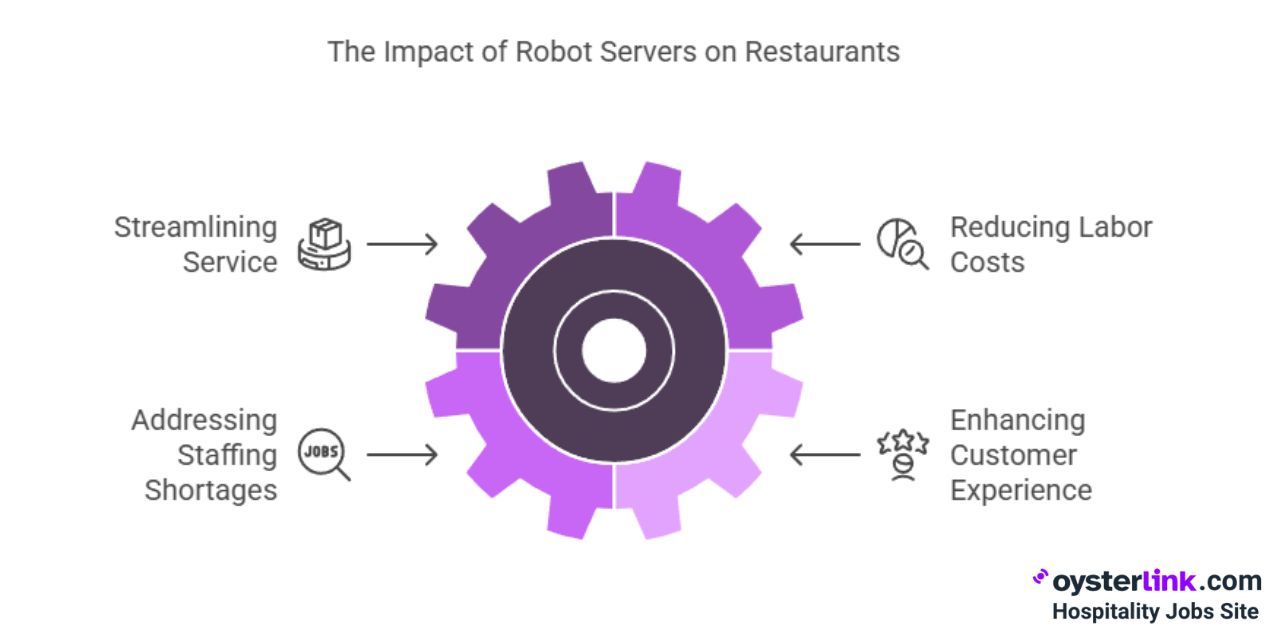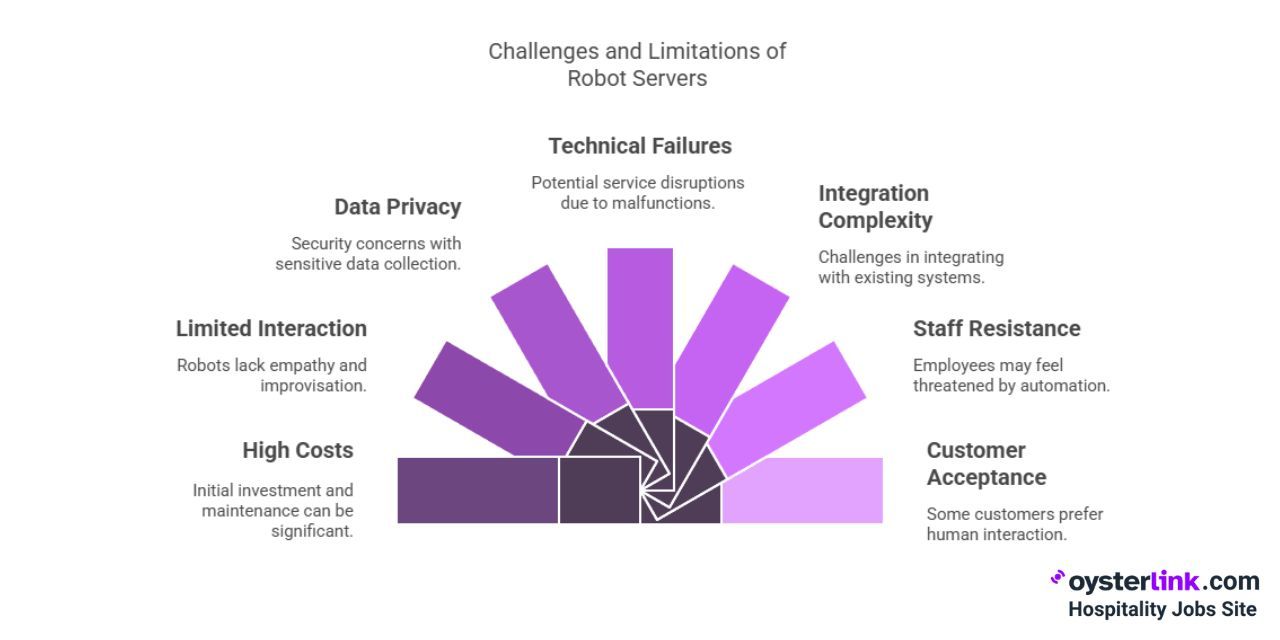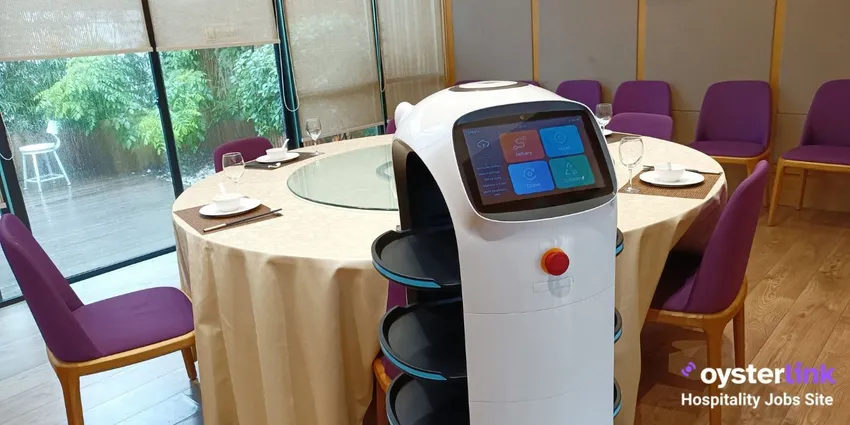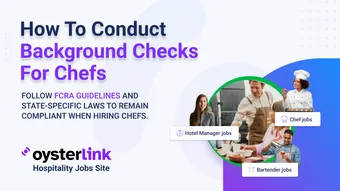Restaurants With Robot Servers Key Takeaways:
- Robot Servers offer solutions for labor shortages and rising payroll costs by automating routine tasks, such as food running and guest guidance.
- Total investment per robot usually falls between $10,000 to $20,000 (setup included).
- Today’s robots use advanced AI, LiDAR/cameras and POS integration, navigating busy dining rooms while syncing with your restaurant’s existing digital systems.
- Robot Servers increase efficiency and the “wow” factor, but still require support teams for tasks involving nuanced customer service, crowd control and quick troubleshooting.
Many restaurants, especially independent locations and fast-growing franchises, are struggling to keep up with rising labor costs and ongoing staff shortages — leading to slower service, unpredictable overtime and frustrated guests.
Robot Servers are being adopted as a practical response, promising steadier workflows and a tech-forward edge that can set a restaurant apart from competitors. This article examines how restaurants with robot servers are transforming the hospitality industry.
How Robot Servers Are Transforming Restaurant Operations
Robot Servers are automated machines designed to carry out front-of-house tasks like delivering food, assisting with seating and engaging with guests with a touch of novelty.
While their presence first grew out of pandemic-era priorities like minimizing contact, they’re now increasingly viewed as strategic, long-term tools for restaurant operators seeking both operational efficiency and unique guest experiences.
The arrival of robot Servers is shifting restaurant operations in measurable ways. By automating routine jobs, robots help maintain service standards — especially in times when it’s tough to fill late or weekend shifts with dependable staff.
Streamlining service and order delivery
Robot Servers excel at repetitive tasks: running food and drinks to tables, returning dirty dishes, bringing condiments and in some cases processing payments or taking orders via a touchscreen.
This frees up human team members to focus on higher-touch guest engagement, such as chatting with regulars, problem-solving and handling special requests. Meanwhile, robots maintain a consistent service pace, even during peak hours or when staff numbers are limited.
Reducing labor costs and addressing staffing shortages
With fewer job seekers available for late shifts, night closes or entry-level positions, robots are being used to fill operational gaps and reduce reliance on unpredictable staffing. Robots operate long hours without breaks and can cover for last-minute call-outs — helping managers keep payroll under control and reduce stress on their core team.
Restaurant operators find that by automating routine tasks, they can invest more in cross-training, staff recognition and guest amenities — turning savings into lasting competitive advantages.
Enhancing customer experience
Families and tech enthusiasts are often attracted by Robot Servers’ novelty: musical greetings, jokes and LED displays can create a “photo-worthy” moment, boosting word-of-mouth buzz. For suburban or family-focused restaurants, robots can be a differentiator that attracts repeat visits — as long as the service remains warm and hassle-free.
Some robots are equipped with AI to recognize returning guests and remember preferences, giving operators a way to personalize return visits and improve loyalty program engagement.

Technological Innovations Behind Robot Servers
Robot Servers combine several advanced technologies: robust AI, restaurant-grade sensors and integrations with digital ordering platforms. Adoption is easier for restaurants that already have POS and online ordering tools in place.
Artificial intelligence and machine learning applications
Today’s robots use AI to tailor interactions, recognize repeat guests and adapt workflows during busy hours. Machine learning improves routing — helping robots optimize which tables to run based on traffic or kitchen timing and learning from operational lapses.
Over time, these systems become more “intuitive” and reliable but owners should plan for a training period and regular updates to maximize accuracy.
Navigation and safety features
Indoor robots use a variety of sensors — like LiDAR, cameras and ultrasonic detectors—to navigate around children, highchairs, crowded aisles and staff moving through the space. Safety features such as fail-safe routines and automatic braking help minimize risks, especially in family-friendly environments.
Still, it's a good idea for operators to review safety during demonstrations and update protocols whenever necessary.
Integration with digital ordering systems
Connecting POS and online ordering platforms streamlines the restaurant’s workflow. Orders placed by phone or tablet can be transmitted directly to robots for delivery, reducing handoffs and minimizing errors. When upgrading the tech setup, compatibility and support ease are important considerations to discuss with vendors.
Faster table turnover, improved order accuracy and real-time updates can enhance profitability, especially when paired with loyalty programs or guest feedback systems. Maintaining a well-trained staff remains crucial to ensuring smooth operations alongside digital enhancements.
Challenges and Limitations of Robot Servers
Despite their benefits, Robot Servers come with challenges that should be considered before deployment:
- High costs and maintenance: Initial investment ranges from $10,000 to $20,000 per unit. Budget for regular maintenance, repairs and support. Pilot projects during off-peak hours can help assess value before full rollout.
- Limited human interaction: Robots lack empathy and improvisation, especially with complex requests or special occasions. Use them as helpers, not replacements, and involve staff in demos to promote adoption.
- Data privacy and security concerns: Robots collect sensitive information, so choose vendors with strong security and privacy policies. Train staff to handle guest questions and review legal obligations related to data protection.
- Technical failures and downtime: Machines can experience malfunctions or connectivity issues, potentially disrupting service. It's important to have backup plans, such as manual processes or spare units, to mitigate downtime.
- Integration complexity: Ensuring compatibility with existing POS, online ordering and management systems can be complicated. Proper planning, vendor support and staff training are essential for seamless integration.
- Staff resistance or anxiety: Some employees may feel threatened or resistant to robotic automation. Open communication, involving staff early in deployment and highlighting how robots support their work can foster cooperation and reduce resistance.
- Customer acceptance: While many guests enjoy novelty, others prefer human interaction. Managing guest expectations and clearly communicating the role of robots helps prevent dissatisfaction.

Real Restaurants Using Robot Servers Today
Several restaurant chains and individual locations have begun experimenting with robot servers to enhance efficiency and guest experience. Examples include:
Chick-fil-A
Some Chick-fil-A locations have introduced robot-powered delivery to assist with food transport within the restaurant, helping reduce wait times and improve service speed.
Denny’s
Certain Denny’s restaurants have piloted robot servers that deliver food and drinks to tables, adding a novelty factor that attracts customers and streamlines service during busy hours.
Tofu House — San Diego
This popular Korean restaurant employs robot servers to carry dishes from the kitchen to tables, helping staff focus more on customer interaction and less on routine tasks.
Wing Factory — Atlanta
Wing Factory locations have incorporated robots to deliver orders to diners, enhancing operational flow and offering a unique dining experience.
The Future of Robot Servers in Hospitality
As guest expectations evolve and staffing remains volatile, more restaurants will pilot hybrid human-robot approaches. Early and transparent communication with both guests and staff helps ensure a positive experience, encouraging repeat business and positive reviews.
Hybrid approaches: human-robot collaboration
Leading operators use robots to automate repetitive or physically demanding tasks while assigning seasoned team members to greet guests, troubleshoot and personalize the experience.
This “hybrid hospitality” strikes a balance — staff aren’t replaced but empowered to focus on the unique human touches that drive loyalty and feedback.
Impact on jobs and workforce adaptation
While some labor needs may shift, robot adoption creates new opportunities: training tech leads, hiring robot technicians or adding digital guest service managers.
Owners who offer upskilling and cross-training (even as simple as a short Saturday session) help maintain morale and can uncover “champions” who drive tech adoption across various locations.
Potential for expansion beyond restaurants
In the future, Robot Servers may appear at hotel banquets, sporting events (imagine one helping during a local basketball game!) or airport lounges — delivering food, guiding guests or performing check-ins.
Practical Tips: Piloting Robots in Your Restaurant
Implementing robot Servers requires careful planning and gradual testing. To ensure a smooth integration, consider these practical tips:
- Start small: Trial robots during slow hours or special events to gather staff and guest feedback without disrupting core business.
- Involve your team: Encourage Managers, Servers and kitchen leaders to test features, voice concerns and help design new workflows.
- Focus on family appeal: Market the robots for kids’ nights or birthday parties to generate buzz — ask parents and regulars for candid opinions.
- Track ROI (Return on Investment): Monitor payroll, maintenance costs and guest satisfaction closely—consider digital surveys or POS-integrated metrics.
- Announce changes transparently: Notify regulars if testing robots and explain how it will (and won’t) change the dining experience.











Loading comments...